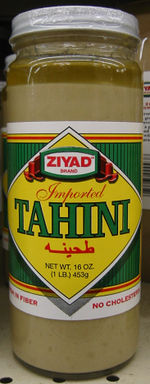Tahini


Tahini (Arabic tahina: طحينة), zhimajiang (芝麻醤 - Chinese), nerigoma (ねりごま - Japanese), טחינה (tahina or t'hina - Hebrew), Tashi (τασιή) in Cyprus or sesame paste is a paste of ground sesame seeds used in cooking. North African/West Asian tahini is made of hulled, lightly roasted seeds. East Asian sesame paste is made of unhulled seeds. Sesame in Hindi and Urdu lanuages of India is 'Til'. It is used in various forms in Indian dishes It is also ground as a paste along with poppyseeds.
Tahini is a major component of hummus and other Middle Eastern foods. It is sold fresh or dehydrated.
Sesame paste is an ingredient in some Chinese, Korean, and Japanese dishes; it is used in some versions of the Szechuan dish Dan dan noodles. Because East Asian sesame paste is made from unhulled seeds, it is more bitter than tahini.
Contents |
Etymology
Tahini is from an Arabic loanword to English. طحينة [tˁaħiːna:], or more accurately ṭaḥīnīa طحينية, is derived from the root طحن tˁ-ħ-n which as a verb means 'to grind',[1] the same root as طحين [tˁaħiːn] 'flour'. It is also a loanword from the Hebrew word of the same root (טחינה) also meaning ("to grind").[2][3][4][5]
The standard Arabic spelling طحينة ends in an ah sound (ة), like the Hebrew, and it is pronounced with an a,ah, or uh sound in most Arabic dialects. In Syrian and Lebanese dialects, however, this sound is generally pronounced eh. Since most 19th and early 20th century Arab immigrants to English-speaking countries were from Syria and Lebanon, this may be the origin of the English usage of the final i. The final i could also derive from the use of the word not as a noun but rather in adjectival form. In Arabic, like in English, one can make an adjective from a noun by adding a final ee sound (peachy), so one might say that a sauce was not tahina, but was tahini, meaning 'like tahina', or 'flavored with tahina'.
History
Tahini is mentioned as an ingredient of Hummus Kasa, a recipe transcribed in an anonymous 13th century Arabic cookbook, Kitab Wasf al-Atima al-Mutada.[6]
Tahini originates in ancient Persia (Iran), under the name ardeh (ارده) 'holy food'.
Uses
Tahini paste is used in a variety of dishes. Tahini-based sauces are common in Middle Eastern restaurants as a side dish or as a garnish, usually including lemon juice, salt and garlic, and thinned with water. Tahini sauce is also a popular condiment for meat and vegetables in Middle Eastern cuisine. In addition, it is a main ingredient in soups. As a spread, Tahini can replace peanut butter on bread, though the flavor and texture are quite different.
In Turkey, tahini (tahin in Turkish) is mixed with pekmez to form a dish called tahin-pekmez. Due to its high-calorie nutritious value, it is served as a breakfast item or after meals as a dessert to dip pieces of bread in, especially during the wintertime.
In Iraq and some Persian Gulf countries, tahini is mixed with date syrup (rub) to make a sweet dessert usually eaten with bread.
In Cyprus, tashi is used as dipping for bread and in Pitta Souvlaki rather than tzatziki, which is customary in Greece.
In Egypt, tahini is automatically added to virtually all sandwiches unless one requests it not to be. Ful Iskandrani (Alexandrian ful) is a popular preparation of ful with hot peppers and generous tahini.
Tahini is also the main ingredient in the Mediterranean type of halva.
Tahini is becoming more common in European cuisine and can be found as an ingredient in some pre-packaged sandwiches.
Tahini is an important ingredient in hummus.
Tahini is often used to thicken soups and salad dressings.
References
- ↑ Ghillie Basan, Jonathan Basan (2006), The Middle Eastern Kitchen: A Book of Essential Ingredients with Over 150 Authentic Recipes, p.146, Hippocrene Books
- ↑ All about Tahini
- ↑ What is tahini?
- ↑ Babylon English grind .."crush small (heb. tahan)"
- ↑ Strong's Hebrew Dictionary.."from 'tachan' (2912); a hand mill..to grind."
- ↑ Alice Fordham (October 10, 2008). "Middle Eats: What are Lebanon’s chances of legally laying claim to hummus?". NOW Lebanon. http://www.nowlebanon.com/NewsArticleDetails.aspx?ID=62188. Retrieved 2008-11-25.
Bibliography
- Basan, Ghillie; Basan, Jonathan (2006). The Middle Eastern Kitchen: A Book of Essential Ingredients with Over 150 Authentic Recipes. Hippocrene Books. ISBN 0781811902, 9780781811903